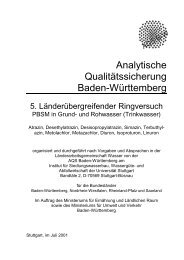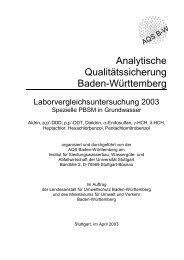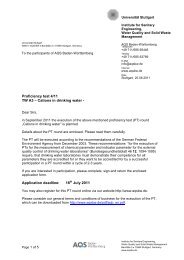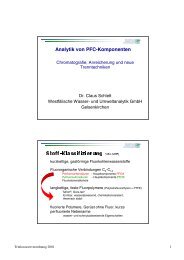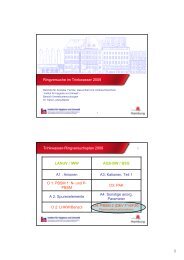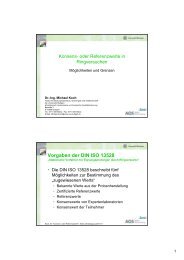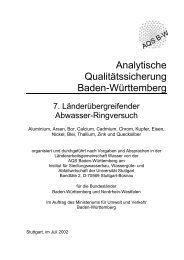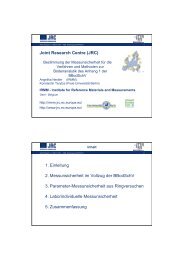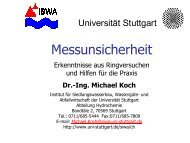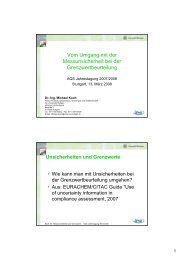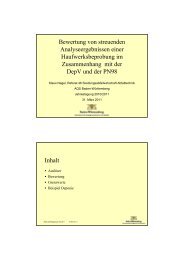Institute for Sanitary Engineering, Water Quality and Solid Waste ...
Institute for Sanitary Engineering, Water Quality and Solid Waste ...
Institute for Sanitary Engineering, Water Quality and Solid Waste ...
Create successful ePaper yourself
Turn your PDF publications into a flip-book with our unique Google optimized e-Paper software.
<strong>Solid</strong> <strong>Waste</strong> Management SIA<br />
waste prevention, recycling <strong>and</strong> waste treatment<br />
in the EU-27.<br />
put/output (I/O) balance of each stage is (dynamically)<br />
linked to the others.<br />
With this STREP proposal, sound experiences on resources<br />
<strong>and</strong> waste management are combined in order<br />
to give direct decision <strong>and</strong> policy support. The partnership<br />
experience is mainly characterised by:<br />
• European <strong>and</strong> National experience in policy support;<br />
• The access to data from various countries (particularly<br />
East <strong>and</strong> South);<br />
• Availability of a successfully applied assessment<br />
tool (NAMEA, MFA), along with more insight in<br />
processes <strong>for</strong> various waste streams (AWAST simulator);<br />
• An extensive network in resources <strong>and</strong> waste management.<br />
The project aims at accounting <strong>for</strong> all sectors in the<br />
economy (the figure below shows a possible conceptual<br />
organisation of the system) the flows, stocks <strong>and</strong><br />
linked environmental pressures to increase the reliability<br />
of source data used in “Life Cycle Approaches” to<br />
waste management issues.<br />
<strong>Waste</strong> policies influence the „primary production“ due<br />
to recycling <strong>and</strong> prevention, the „manufacturing <strong>and</strong><br />
consumption“ stages due to recycling, reuse <strong>and</strong> prevention<br />
<strong>and</strong> the „waste management“ sector. The in-<br />
As an example, the following figure shows the situation<br />
of s<strong>and</strong> <strong>and</strong> gravels in Austria. The net balance<br />
between the consumption <strong>and</strong> the stock (104-10 Tg/<br />
year) represent the net balance of the primary sector<br />
(105-9 Tg/year), which means that the evolution of<br />
this stock (age) is of primary importance <strong>for</strong> a policy<br />
aiming at resources saving.<br />
The difficulties of establishing that type of figure <strong>for</strong><br />
resources saving in Europe are at two levels:<br />
• Data quality: considering the disparity of I/O country<br />
data quality in the EU, it is anticipated to set<br />
out a global mapping of materials cycles in three<br />
steps: 1) elaboration of a global model <strong>for</strong> matter<br />
balance applicable in all countries, 2) calculation<br />
of the so-called “transfer coefficients” with “reliable<br />
<strong>and</strong> complete” country data (four countries),<br />
<strong>and</strong> 3) extension to EU-27 macro-economic data.<br />
• Completeness: considering the variety of resources,<br />
<strong>and</strong> eventually associated secondary resources<br />
(as in ores), <strong>and</strong> their mixed occurrence in the<br />
products, it will be necessary to combine the “materials<br />
flows <strong>and</strong> stocks setting” approach with a<br />
more global Input/output modelling <strong>for</strong> individual<br />
countries <strong>and</strong> <strong>for</strong> EU.<br />
Conceptual system description<br />
87




